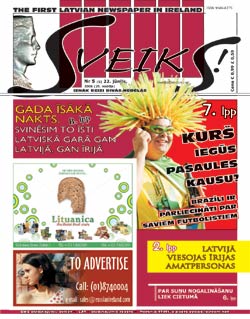You have just created a new Latvian product or service, or have finally made the decision to establish an Internet presence for your Latvian organization, business, hobby or even the family blog. How do you select the domain name?
Lets say that Pēteŗa Pīrāgi, located in Kuldīga, wants to promote its locally popular bakery not only to the rest of Latvia, but to rest of the world. The owner should first sit down (best without a computer) and make a list of words and phrases that people are likely to enter into a search engine such as Google or input as a Web address. For example piragi, pīrāgi (with all the diacritics), Latvian food, beķereja, Latvian bakery, Baltic bacon buns, Baltic food delicacies or visiting Kuldīga. The longer the list the better.
The owner will have two audiences to target: one within Latvia and the Baltic States and the other in the rest of the world. For this reason they may need to go to at least two different registrars: one that handles the .lv domain and the other the popular .com space. The recently introduced European Union .eu top level domain may also be a consideration especially if the owner is expecting an influx of German, Dutch or British tourists to the bakery.
Latvia’s top level domain .lv is managed by the Network Solutions Department of the Institute of Mathematics & Computer Science at the University of Latvia. The department’s Web site is available in either Latvian or English. Visitors can quickly check whether a domain name is available at www.nic.lv. From the list start with the more generic or popular words. You never know your luck, because a previous holder of that name could have recently released it back to the pool of available names. During the 1990s the rules for registering a domain name were fairly lax. At one stage riga.lv was redirecting to a Russian language Web site that had little to do with promoting Rīga. Cybersquatters would often purchase a whole bunch of names with the intent of selling them to unsuspecting firms for many times the original price. Nearly 40,000 .lv domain names have been registered (compared to more than 50 million .com registrations) and the rules today ensure that geographical names and well known company names or trademarks are protected from these warehousing practices. Naming conventions are generally more relaxed and a business or organisation can register at the top domain without the .com.lv or .org.lv extension, for example, mybusiness.lv and myorganisation.lv. Domain names designated with the .id.lv extension are available free of charge for individuals. Surprisingly, a lot of the more popular surnames are still available (only 500 have been registered), so grab one while you can.
Going back to our example, the owner of Pēteŗa Pīrāgi is overjoyed to discover that the No. 1 choice of pirags.lv was available. Out comes the credit card and, after completing all of the necessary details and authorising the USD 35 or EUR 30 charge, the domain name can now be exclusively used by the bakery for 12 months, after which a renewal notice for the same amount will be sent for the following year. In 2004 NIC.lv also introduced the ability to include Latvian letters or diacritics. These domain names are considerably cheaper at LVL 10. The main problem is that for nearly all versions of Microsoft’s Internet Explorer a special plugin is required to recognise the special letters. Otherwise the user is taken to the standard “Server Not Found” error page. To implement this great idea, the owner of the bakery should have both pirags.lv and pīrāgs.lv for exclusive use and at no additional charge, at least until the technology has caught up and the Domain Name System has become Unicode compliant. NIC.lv provides tūdaliņ.lv as an example to test your Web browser.
For the dot com space Pēteŗa Pīrāgi will need to go to one of the many thousands of registrars located outside of Latvia. Some of the more popular are Register.com, NetworkSolutions and DomainDiscover, where prices start from a low USD 9 for a domain name—nearly 400 percent cheaper than the Latvian equivalent. At these prices Pēteŗa Pīrāgi can register several names, for example, pirags.com, latvianbakery.com and balticbaconbuns.com and have them all automatically redirect to the English language pages of pirags.lv.
The European Commission’s nonprofit organisation EURid has accredited three .eu registrars in Latvia, but only EUREG seems to work and inexplicably defaults to the Russian language. Prices for .eu domain names are quoted at about LVL 15. To date there have been about 3,000 registrations from Latvia. It is not clear whether these figures also includes the reserved names. The owner of Pēteŗa Pīrāgi decides they will watch this space and make an assessment later.
Selecting a domain name is only the initial phase of successfullty establishing an online presence and something that every business should consider sooner than later.




